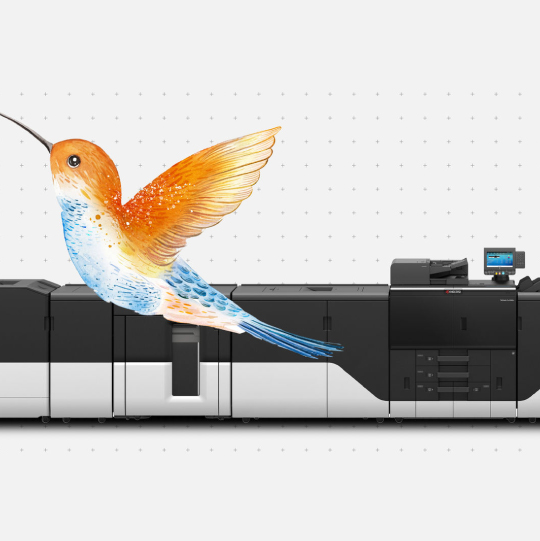In today’s print environment, accurate brand-colour reproduction is no longer a luxury, it’s a fundamental expectation. Whether you’re producing marketing brochures, packaging, client-facing reports or promotional materials, a slight deviation in that signature turquoise or deep burgundy can dilute your brand identity and erode trust. For print and design teams, and especially for organisations outsourcing or managing in-house production, the question is: how do you ensure consistency every time across devices, substrates and campaigns?
This article explores why brand-colour accuracy matters, what the technical challenges are, and how leveraging advanced tools, especially the Fiery colour-management suite, in tandem with high-quality hardware such as those from Kyocera can help you deliver flawless brand colours at scale.
Why brand-colour accuracy matters
- A brand is more than a logo and colour is a key part of brand recognition. Consistent use of brand-colours across print, digital, packaging and signage supports immediate recognition and reinforces trust.
- Print jobs often need to align with other brand touchpoints (web, packaging, signage). If the printed colour deviates under lighting, across runs, or on different media, the brand image can be impacted.
- In production print and contract print-service environments, inaccurate spot colours or inconsistent CMYK conversions can result in costly reprints, wasted media and delays. For example, according to a whitepaper from Fiery, achieving certified colour consistency (such as through ISO or FOGRA standards) “leads to more efficient and reproducible workflows, a reduction in consumption of consumables and therefore lower production costs and higher productivity”.
- For organisations with brand guidelines, especially those making external print-deliverables through agencies or service bureaus, the ability to match spot colours (such as PANTONE) is often a contractual requirement.
A brand is more than a logo and colour is a key part of brand recognition.”
The technical challenge: from design to print
Producing brand-accurate colours involves more than just sending a PDF to the printer. Some of the obstacles include:
1. Spot vs process colours – Many brands define their colours as named spot colours (e.g., PANTONE 186 C). But output devices often work in CMYK (and sometimes extended gamut). Ensuring the spot colour is accurately reproduced (or mapped) is a key step.
2. Gamut limitations and device variation – Different printers, toners, media and finishing processes all affect final appearance. A brand-colour match on one device may look different on another unless calibrated.
3. File- and workflow-pitfalls – RGB originates in design applications but print often needs CMYK or specific ICC profiles. If files are submitted incorrectly or with inappropriate profiles, the output will deviate.
4. Reprint and cross-device consistency – Ensuring that a job printed today can be reprinted next month, or on a different device, and still match is a recurring need. Print software tools allow verification and monitoring of colour quality over time.
In short: without a robust colour-management workflow, brand-colour consistency becomes a recurring pain-point.
How colour-management software supports brand-colour workflows
Modern colour-management systems provide a comprehensive toolset to help print professionals achieve consistent, accurate brand reproduction across devices and materials. These platforms typically include spot-colour management, profiling tools, and verification features designed to maintain precision from file creation through to final output.
Spot-colour management: Advanced colour tools allow users to define, edit, and store custom spot colours based on exact LAB or CMYK values, or by capturing references via a spectrophotometer. This ensures that brand colours are reproduced consistently, regardless of the file’s original RGB or CMYK composition.
Centralised colour libraries: Many systems support shared colour libraries, enabling collaboration between designers and print operators. When colour data is stored centrally and applied automatically, it reduces human error and ensures that every document adheres to brand guidelines.
Accurate output from office applications: Integrated print drivers and software plug-ins can help maintain colour integrity even when printing from standard office tools such as Microsoft Office or Adobe Acrobat — so reports, presentations, and marketing materials retain the same brand tone as high-end collateral.
Verification and consistency: Measurement-based profiling and verification tools allow print teams to benchmark colour output against recognised standards such as ISO 12647 or FOGRA. Regular calibration and verification safeguard against drift and ensure repeatable results across different devices and production runs.
Integration with Kyocera hardware: Kyocera’s professional-grade print engines, such as the TASKalfa Pro 15000c, are designed to integrate seamlessly with colour-management workflows. By combining high-precision hardware with intelligent colour-control software, organisations can achieve exceptional consistency and reduce waste, reprints, and downtime.
By using these tools together, print teams can take full control of colour performance — from design through production — ensuring that every output meets the brand’s visual standards while keeping processes efficient and sustainable.
How Kyocera enables brand-colour precision in practice
A practical, colour-accurate workflow typically follows these key stages:
1. Define and capture brand colours. Use a spectrophotometer or colour-reference chart to capture exact LAB or CMYK values for each brand tone, and document them in a shared colour library.
2. Map and manage colours. Load these values into your colour-management software so that they are applied automatically during print processing.
3. Calibrate devices and media. On your Kyocera device, set output profiles and calibration appropriate to your substrate and finishing process.
4. Maintain colour integrity across applications. Ensure that office and creative-suite applications use the same ICC profiles and colour references to eliminate discrepancies between file types.
5. Verify and maintain. Schedule regular calibration and verification sessions to monitor colour accuracy and detect drift early.
6. Share and communicate. Distribute standardised colour profiles to internal teams and external partners so that colour reproduction remains consistent, regardless of where or when materials are printed.
The result is a controlled, reliable workflow that ensures consistent colour across every print run, device, and campaign. By reducing trial-and-error and reprints, organisations save time and cost by delivering predictable, high-quality output which strengthens brand integrity and customer trust.
Outcomes and benefits
- Reduced waste & reprints: With proper colour-management the number of mis-matched colour jobs falls significantly, leading to lower consumable and media costs.
- Brand integrity and visual consistency: Whether it’s a client brochure, poster or packaging run, the brand-colour remains consistent across output.
- Faster job turnaround: Because spot-colours are set up and managed centrally, fewer ad-hoc adjustments are required by operators or designers so jobs move faster.
- Cross-device consistency: When devices are calibrated and share colour libraries, reprints or jobs on different engines still match.
- Competitive advantage: For organisations offering colour print services, the ability to guarantee brand-colour accuracy can be a key differentiator in the market.
How can you implement print software today?
Brand-colour accuracy is no longer just a “nice-to-have”. In a world where your printed output must align with digital, signage and packaging touchpoints, any deviation risks diluting your brand. By adopting a workflow built on robust colour-management tools and pairing them with high-quality hardware such as Kyocera's print engines, you put yourself in control of colour outcomes.
To achieve this, start by auditing your current print-colour processes to identify where mismatches or inconsistencies occur. Collaborate closely with designers and print partners to ensure brand colours are defined using precise LAB or CMYK values and consistently shared across the workflow. Invest in spot-colour management solutions to streamline colour control and enhance operational efficiency and verify that your print engines support software integration and are correctly calibrated for the media in use. Establishing a regular verification schedule will help maintain accuracy over time and prevent printer drift.
By taking these steps, you’ll not only improve visual consistency, you’ll enable your business to deliver exceptional, brand-secure print output at scale.




